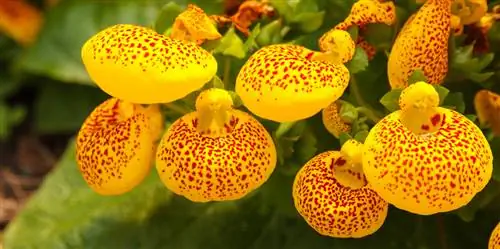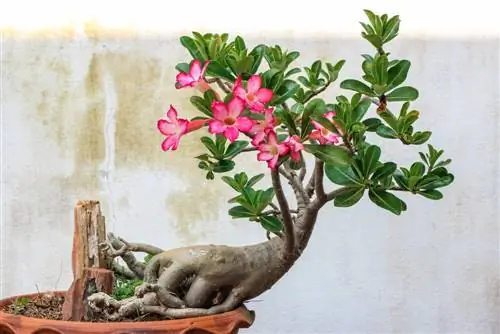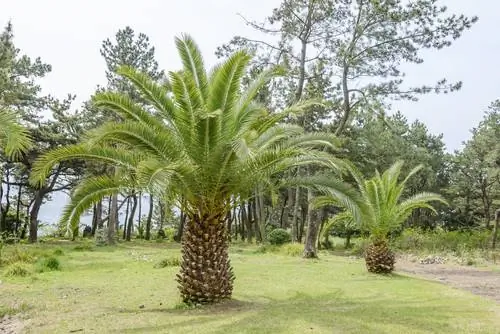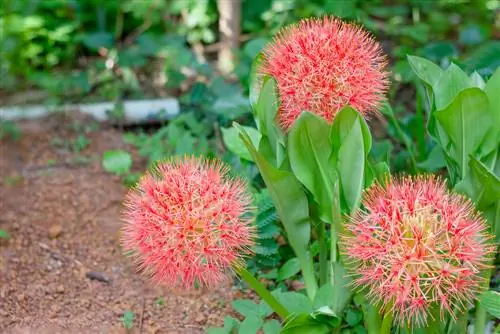- Author admin [email protected].
- Public 2023-12-25 17:45.
- Last modified 2025-01-23 11:22.
Has the busy natural beauty not yet settled in your green kingdom on its own? Then it is high time to plant the spur flower in sunny, warm and dry locations. With opulent flower spikes in white, pink or red over bushy, lanceolate foliage, Centranthus create floral lushness in beds and containers. Any questions you still have about this undemanding perennial will be answered here.
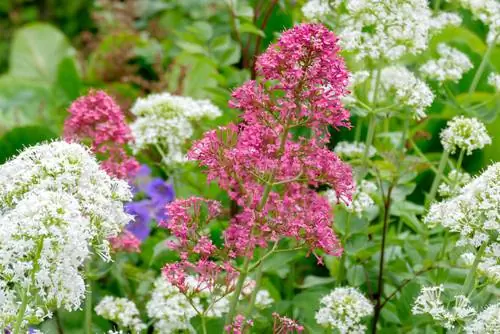
What are the special features of the spur flower?
The spur flower (Centranthus) is a frugal, perennial herb that prefers sunny, warm and dry locations. It blooms profusely in white, pink or red from June to August, with a repeat bloom in September if pruned and fertilized after the main bloom.
Planting spur flowers correctly
Late summer is the ideal planting time for fully grown young perennials. Before starting work, place the still potted root balls in water. Meanwhile, the loose, sandy-humous to fresh soil in the sunny location is weeded and raked. Dig spacious planting holes 45 to 50 cm apart that are 1.5 times the volume of the root ball. Mix some ripe compost (€43.00 on Amazon), horn shavings or guano into the excavation. If the soil doesn't seem loose enough to you, a handful of sand will compensate. Plant the potted Centranthus so that the previous planting depth is maintained and water. Ideally, the planting site can now be mulched with gravel or chippings, which keeps the soil warm longer and encourages root growth.
Care tips
Looking at the care program of a Centranthus proves its modest character. If the perennial finds the right location, proper cultivation is limited to the following measures:
- Water spur flowers in the morning or evening when it is dry
- Organic starting fertilization in April/May is beneficial, but not mandatory
- A and O of care is pruning by a third after the first flower bloom
- Following pruning, further fertilization promotes rebloom
- Cut close to the ground either in autumn or early spring
In the first two years it makes sense to pile up the root disc with leaves, straw or brushwood. Once the frost hardiness has developed, there is no need for winter protection in the following years.read more
Which location is suitable?
The Mediterranean Centranthus feels at home in sunbeds that are warm and protected. There should be at least 6 hours of sunshine in the summer that shine over the lush flower spikes. In addition, the spur flower prefers sandy, dry to fresh soil that has first-class water drainage.
The correct planting distance
Due to the broad bushy habit, the planting distance of a Centranthus should not be too tight. In the best case scenario, the distance to the neighboring bed should be between 45 and 50 cm so that the flowers do not crowd each other. If the spur flower covers a larger area, we recommend an arrangement of 4 to 5 specimens per square meter, ideally not in rows.
What soil does the plant need?
Where the spur flower settles uninvited and yet warmly welcomed, it prefers sandy-dry to freshly moist soil. Therefore, choose a sunny location whose soil is humus, loose and well-drained. The Centranthus does not place any unusual demands on the pH value as long as it is in the neutral to alkaline range.
When is flowering time?
Mother Nature endowed the spur flower with the ability to rebloom. The main flowering period extends from June to August. If you then cut the Centranthus back by a third and add a little compost to the roots, it will give it another start for another bloom from September.
Cut the spur flower correctly
In the context of successful cultivation of spur flowers, cutting and flowering time are closely related. If you cut back a Centranthus by a third after the main flowering in August, fresh buds will form that will bloom in September. If this rebloom runs out of steam before the first frost, cut the perennial back close to the ground. In this way, the plant finds enough time to gather new strength before next year's budding instead of investing its energy in seed formation.read more
Watering spur flower
The humble Centranthus is usually content with the amount of rain. In dry summers, it still makes sense to water the spur flower. Apply the irrigation water directly to the root disc using the can spout in the morning or evening. If the sensitive flower spikes are rained on under sunlight, every single drop of water turns into a burning glass that destroys the petals.
Fertilize the spur flower properly
Giving fertilizer to spur flowers is not mandatory. Nevertheless, the perennial gratefully accepts organic starter fertilization in April/May. Add compost, horn shavings, bark humus or guano granules to the root disc to lightly rake in the material. It is beneficial for the subsequent flowering if you repeat this measure after the summer pruning.
Wintering
Since the frost hardiness of a Centranthus only develops over time, we recommend light winter protection in the first two years. After the autumn pruning, spread a layer of autumn leaves, brushwood or straw over the root disk. As soon as there is no longer any bitter frost in early spring, the protective layer is removed so that sprouting is not hindered.
Propagate spurflower
You can easily leave the further distribution to a Centranthus, because it reproduces continuously by self-sowing. In this case, do not cut the plant back in autumn, but do the cut in January/February. For targeted offspring, the only option available in the hobby garden is to grow them behind glass, as division or propagation from cuttings is usually futile.read more
How do I transplant correctly?
Since Centranthus, as a valerian plant, develops a strong, fleshy taproot, it does not survive a change of location. Since it is difficult to avoid damaging the deep roots when transplanting, we advise against this measure. This is accompanied by the fact that rejuvenation or division of the perennial is rarely successful.
Is spurflower poisonous?
As a subfamily of the valerian family, Centranthus is one of the harmless perennials. No harmful substances flow through the delicate plant veins, making the spur flower ideal for cultivation in the family garden. Even the red spurflower (Centranthus ruber), which is used as a medicinal herb, contains neither essential oils nor alkaloids.
Trivia
The red spur flower (Centranthus ruber) contains a plant-based active ingredient that gave it the nickname “herb of immortality”. The plant species contains up to 5% valepotriate, more than real medicinal valerian has to offer. This plant substance is said to have a balancing effect. The medicinal herb has a sedating effect on fluttering nerves, while it awakens your spirits when you feel tired. The magical leaves are consumed as tea or fresh in salad.
Beautiful varieties
- Albus: The robust variety stands out with bright white flowers from June to September
- Rose red: Fairytale Centranthus, whose light red flowers magically harmonize with the white blooming Albus
- Coccineus: Premium varieties whose crimson umbels add magical touches of color to the garden
- Small Spur Flower: A compact Centranthus with pink flowers and a delicate habit


